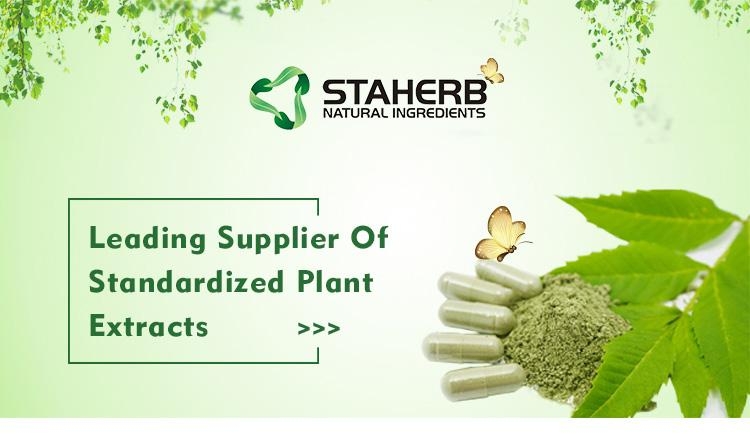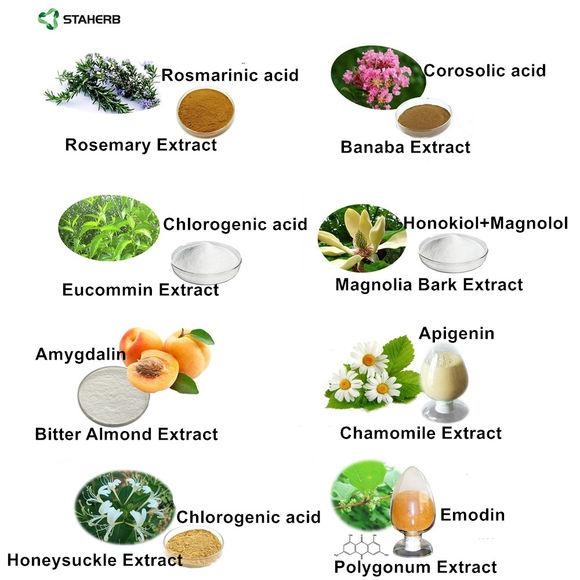- Standard Extract(575)
- Reference substance(27)
- Proportional Extract(349)
- SFE-CO2 Extract(3)
- Other extracts(53)
- High purity(103)
| Changsha Staherb Natural Ingredients Co., Ltd., | |
|---|---|
| Country: | China |
| Tel: | 86-731-84213302 |
| Mobile: | 18374838656 |
| E-mail: | info@staherb.cn |
| QQ: | |
| Skype: | Chat Now! |
seabuckthorn fruit oil
Release time: 2022-06-07
seabuckthorn fruit oil
Product name: pure SeaBuckthorn fruit Oil
Latin Name: Hippophae Rhamnoides
Active Ingredient : Unsaturated Fatty Acids,VE,carotene
Source of extraction: seabuckthorn seed
Extraction type: CO2 Supercritical Extract
Form : Liquid Oil
Place of orign:Changsha,China

About : seabuckthorn berry oil
Seabuckthorn English name Seabuckthorn,Latin name Hippophae Rhamnoides,German sanddorn,Japan is called longevity fruit,Russia called second ginseng,the United States called life energy,India called God fruit,China is called the holy fruit,the king of VC,is a kind of medicine and food homologous plant,is an important raw material used in medicine,cosmetics,health care products and other industries.The export products are mainly seabuckthorn fruit oil,seabuckthorn seed oil,seabuckthorn fruit powder,seabuckthorn capsule OEM,seabuckthorn puree concentrate,seabuckthorn tea and so on.
Sea buckthorn berry oil (Seabuckthorn fruit oil) is extract from Sea buckthorn berry in western of China.The oil is composed of palmitic acid, palmitoleic acid, stearic acid, oleic acid, linoleic acid, linolenic acid and other beneficial fatty acids. Among them, unsaturated fatty acids are up to 70%.
Benefits of seabuckthorn berry oil.
1. Improve the stomach
2. Repair burns, burns, wound healing, repair oral ulcers, stomach ulcers
3. Vitamin supplements
4. Protect liver and protect liver and improve immunity
5. Antioxidant
6. Radiation protection
7. Lighten spots, nourish the skin (for cosmetics), dilute stretch marks
8. Regulate blood lipids
Application of seabuckthorn berry oil:
1. Seabuckthorn leaves can be used to make seabuckthorn tea
2. Seabuckthorn roots, stems and branches can be used to prevent soil erosion and produce Chinese herbal medicines.
3. Seabuckthorn fruit can be used to extract seabuckthorn fruit oil, make seabuckthorn fruit powder, seabuckthorn puree, canned seabuckthorn, seabuckthorn jam, soup, seabuckthorn juice, seabuckthorn dried fruit, seabuckthorn capsule, seabuckthorn snack, etc.
4. Seabuckthorn seeds are used to extract seabuckthorn seed oil
5. Seabuckthorn pomace is used for animal feed, extracting seabuckthorn polysaccharide, seabuckthorn flavonoids, etc.
Nutrition of seabuckthorn berry oil:
Rich in various vitamins, unsaturated fatty acids (Omega-3, Omega-6, Omega-9, Omega-7), trace elements, carotenoids, flavonoids, amino acids, SOD, serotonin, etc.
Pls contact me at email sales09@staherb.cn for more product information.

References:
- 1.
Dale MM, Foreman JC, Fan TD: Textbook of Immunopharmacology, 3rd edn. Blackwell Scientific Publication, London
- 2.
Patwardhan B, Kalbag D, Patki PS, Nagsampagi BA: Search of immunomodulatory agents – a review. Indian Drugs 28: 249–254, 1991
- 3.
Charak Samhita. Translator: Shree Gulabkunverba Ayurvedic Society, Jamnagar, India, 1949
- 4.
Burger AM, Mengs U, Schuler JB, Fiebig HH: Anticancer activity of an aqueous mistletoe extract (AME) in syngeneic murine tumor models. Anticancer Res 21: 1965–1968, 2001
- 5.
Gracious ross R, Selvasubramanian S, Jayasundar S: Immunomodulatory activity of Punica granatum in rabbits – a preliminary study. J Ethnopharmacol 78: 85–87, 2001
- 6.
Zhao W, Ye Q, Tan X, Jiang H, Li X, Chen K, Kinghorn AD: Three new sesquiterpene glycosides from Dendrobium nobile with immunomodulatory activity. J Nat Prod 64: 1196–2000, 2001
- 7.
Kubena KS, Mcmurray DN: Nutrition and the immune system: A review of the nutrient-nutrient interactions. J Am Diet Assoc 96: 1156–1164, 1996
- 8.
Bagchi D, Bagchi M, Stohs SJ: Chromium (VI) induced oxidative stress, apoptotic cell death and modulation of p53 tumor suppressor gene. Mol Cell Biochem 222: 149–158, 2002
- 9.
Shrivastava R, Upreti R, Seth P, Chaturvedi U: Effects of chromium on the immune system. FEMS Immunol Med Microbiol 34: 1–7, 2002
- 10.
Tanigawa T, Araki T, Minato N: Decrease in Leu-11a negative lymphocytes in relation to natural killer cell activity in chromate workers. Br J Internal Med 48: 211–213, 1991
- 11.
Cohen MD, Zeikoff JT, Chen LC, Schlesinger RB: Immunotoxicologic effect of inhaled chromium: Role of particle solubility and coexposure to ozone. Toxicol Appl Pharmacol 152: 30–40, 1998
- 12.
Rousi A: The genus Hippophae L., A taxonomic study. Ann Bot Fenn 8: 177–227, 1971
- 13.
Eccleston C, Baoru Y, Tahvonen R, Kallio H, Rimbach GH, Minihane AM: Effects of an antioxidant rich juice (Seabuckthorn) on risk factors for coronary heart disease in humans. J Nutr Biochem 13: 346–354, 2002
- 14.
Yang B, Kalimo KO, Tahvonen, RL, Mattila LM, Katjisto JK, Kallio HP: Effects of dietary supplementation with sea buckthorn (Hippophae rhamnoides) seed and pulp oils on atopic dermatitis. J Nutr Biochem 10: 622–630, 1999
- 15.
Suleyman H, Gumustekin K, Taysi S, Keles S, Oztasan N, Aksas O, Altinkaynak K, Timur H, Akcay F, Akar S, Dane S, Gul M: Beneficial effects of Hippophae rhamnoides L. on nicotine induced oxidative stress in rat blood compared with vitamin E. Biol Pharm Bull 25: 1133–1136, 2002
- 16.
Goel HC, Prasad J, Singh S, Sagar RK, Kumar IP, Sinha AK: Radioprotection by a herbal preparation of Hippophae rhamnoides, RH-3 against whole body lethal irradiation in mice. Phytomed 9: 15–25, 2002
- 17.
Fushion Z: Comparative research on the contents of seabuckthorn oil and its physical chemical properties, composition of fatty acids and biologically active substance in Northwestern China. Chinese oil and Fat (shanxi) 2: 25–30, 1987
- 18.
Chen Y, Jiang Z, Qin W: Chemistry composition and characteristics of Seabuckthorn fruit and its oil. Chem Ind Forest Products (in Chinese) 10: 163–175, 1999
- 19.
Yao Y, Tigerstedt P: Variation of vitamin C concentration between and within natural seabuckthorn (Hippophae rhamnoides L.) populations. Acta Agric Scand 42: 12–17, 1992
- 20.
Yang B, Kallio HP: Fatty acid composition of lipids in Seabuckthorn (Hippophae rhamnoides L.) berries of different origins. J Agric Food Chem 49: 1939–1947, 2001
- 21.
Geetha S, Sai Ram M, Singh V, Ilavazhagan G, Sawhney RC: Anti-oxidant and immunomodulatory properties of Seabuckthorn (Hippophae rhamnoides) an in vitro study. J Ethnopharmacol 79: 373–378, 2002
- 22.
Sugiyama M, Tsuzuki K, Ogura R: Effect of ascorbic acid on DNA damage, cytotoxicity, glutathione reductase and formation of paramagnetic chromium in Chinese Hamster V-79 cells treated with sodium chromate (VI). J Biol Chem 266: 3383–3386, 1991
- 23.
Sai Ram M, Sharma SK, Ilavazhagan G, Kumar D, Selvamurthy W: Immunomodulatory properties of NIM-76, a volatile fraction from neem oil. J Ethnopharmacol 55: 133–139, 1997
- 24.
Atal CK, Sharma ML, Kaul Khajuria A: Immunomodulatory agents of plant origin. Preliminary screening. J Ethnopharmacol 41: 185–192, 1986
- 25.
Meydani SN, Wu D, Santos MS, Hayek MG: Antioxidants and immune status in aged persons: Overview of present evidence. Am J Clin Nutr 62: 1462S–1476S, 1995
- 26.
Sugiyama M: Role of physiological antioxidants in chromium (VI)-induced cellular injury. Free Radic Biol Med 12: 397–407, 1992
- 27.
Shi X, Chiu A, Chen CT, Halliwell B, Castranova V, Vallyathan V: Reduction of chromium (VI) and its relationship to carcinogenesis. J Toxicol Environ Health B Crit Rev 2: 87–100, 1999
- 28.
Kumar IP, Namita S, Goel HC: Modulation of chromatin organization by RH-3, a preparation of Hippophae rhamnoides, a possible role in radioprotection. Mol Cell Biochem 238: 1–9, 2002
- 29.
Novruzov EN: Flavonoids of different forms of Seabuckthorn (Hippophae rhamnoides L.) growing in Azerbaijan. In: V Singh and PK Khosla (eds). Proceedings of International Workshop on Seabuckthorn, New Delhi, India, 2001, pp 140–146.

